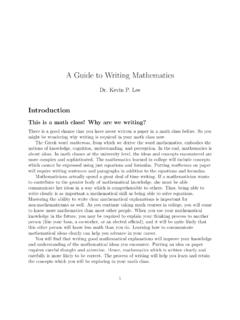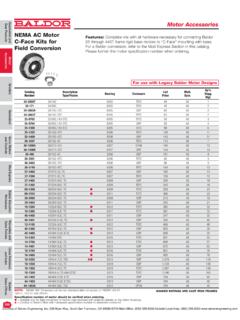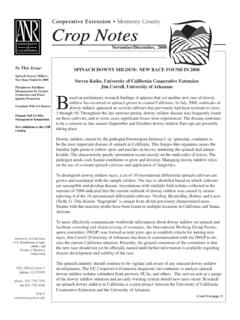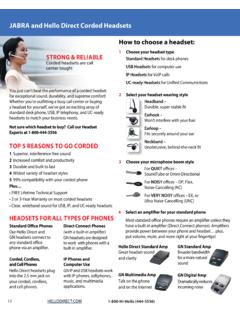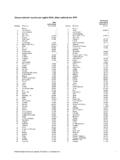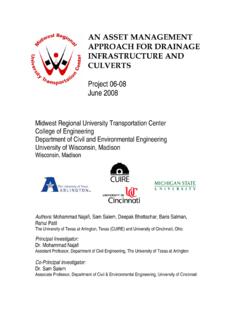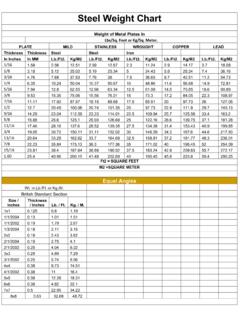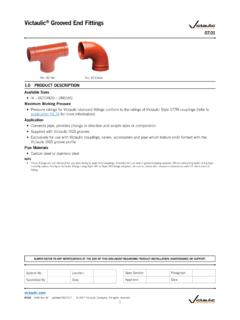Transcription of 8. Query Processing - Computer Science- UC Davis
1 ECS-165A WQ'11 136. 8. Query Processing Goals: Understand the basic concepts underlying the steps in Query Processing and optimization and estimating Query Processing cost; apply Query optimization techniques;. Contents: Overview catalog Information for Cost Estimation Measures of Query Cost Selection Join Operations Other Operations Evaluation and Transformation of Expressions Query Processing & Optimization Task: Find an efficient physical Query plan (aka execution plan). for an SQL Query Goal: Minimize the evaluation time for the Query , , compute Query result as fast as possible Cost Factors: Disk accesses, read/write operations, [I/O, page transfer] (CPU time is typically ignored). Dept. of Computer Science UC Davis 8. Query Processing and Optimization ECS-165A WQ'11 137. Basic Steps in Processing an SQL Query Parser & Relational Algebra SQL Query Translator Expression Statistics Optimizer (System Catalogs).
2 Query Result Evaluation Engine Execution Plan Data Files Parsing and Translating Translate the Query into its internal form (parse tree). This is then translated into an expression of the relational algebra. Parser checks syntax, validates relations, attributes and access permissions Evaluation The Query execution engine takes a physical Query plan (aka execution plan), executes the plan, and returns the result. Optimization: Find the cheapest execution plan for a Query Dept. of Computer Science UC Davis 8. Query Processing and Optimization ECS-165A WQ'11 138. A relational algebra expression may have many equivalent expressions, , CName( Price>5000((CUSTOMERS 1 ORDERS) 1 OFFERS)). CName((CUSTOMERS 1 ORDERS) 1 ( Price>5000(OFFERS))). Representation as logical Query plan (a tree): CName o Price > 5000 CName OFFERS.
3 O Price > 5000. CUSTOMERS ORDERS CUSTOMERS ORDERS OFFERS. Non-leaf nodes operations of relational algebra (with parameters); Leaf nodes relations A relational algebra expression can be evaluated in many ways. An annotated expression specifying detailed evaluation strategy is called the execution plan (includes, , whether index is used, join algorithms, .. ). Among all semantically equivalent expressions, the one with the least costly evaluation plan is chosen. Cost estimate of a plan is based on statistical information in the system catalogs. Dept. of Computer Science UC Davis 8. Query Processing and Optimization ECS-165A WQ'11 139. catalog Information for Cost Estimation Information about relations and attributes: NR: number of tuples in the relation R. BR: number of blocks that contain tuples of the relation R.
4 SR: size of a tuple of R. FR: blocking factor; number of tuples from R that fit into one block (FR = dNR/BRe). V(A, R): number of distinct values for attribute A in R. SC(A, R): selectivity of attribute A. average number of tuples of R that satisfy an equality condition on A. SC(A, R) = NR/V(A, R). Information about indexes: HTI: number of levels in index I (B+-tree). LBI: number of blocks occupied by leaf nodes in index I. (first-level blocks). ValI: number of distinct values for the search key. Some relevant tables in the Oracle system catalogs: USER TABLES USER TAB COLUMNS USER INDEXES. NUM ROWS NUM DISTINCT BLEVEL. BLOCKS LOW VALUE LEAF BLOCKS. EMPTY BLOCKS HIGH VALUE DISTINCT KEYS. AVG SPACE DENSITY AVG LEAF BLOCKS PER KEY. CHAIN CNT NUM BUCKETS. AVG ROW LEN LAST ANALYZED. Dept. of Computer Science UC Davis 8.
5 Query Processing and Optimization ECS-165A WQ'11 140. Measures of Query Cost There are many possible ways to estimate cost, , based on disk accesses, CPU time, or communication overhead. Disk access is the predominant cost (in terms of time);. relatively easy to estimate; therefore, number of block transfers from/to disk is typically used as measure. Simplifying assumption: each block transfer has the same cost. Cost of algorithm ( , for join or selection) depends on database buffer size; more memory for DB buffer reduces disk accesses. Thus DB buffer size is a parameter for estimating cost. We refer to the cost estimate of algorithm S as cost(S). We do not consider cost of writing output to disk. Selection Operation A=a(R) where a is a constant value, A an attribute of R. File Scan search algorithms that locate and retrieve records that satisfy a selection condition S1 Linear search cost(S1)= BR.
6 Dept. of Computer Science UC Davis 8. Query Processing and Optimization ECS-165A WQ'11 141. Selection Operation (cont.). S2 Binary search, , the file ordered based on attribute A. (primary index).. SC(A, R). cost(S2) = dlog2(BR)e + 1. FR. dlog2(BR)e cost to locate the first tuple using binary search Second term blocks that contain records satisfying the selection. If A is primary key, then SC(A, R) = 1, hence cost(S2) = dlog2(BR)e. Dept. of Computer Science UC Davis 8. Query Processing and Optimization ECS-165A WQ'11 142. Example (for Employee DB). FEmployee = 10;. V(Deptno, Employee) = 50 (different departments). NEmployee = 10, 000 (Relation Employee has 10,000 tuples). Assume selection Deptno=20(Employee) and Employee is sorted on search key Deptno : = 10,000/50 = 200 tuples in Employee belong to Deptno 20.
7 (assuming an equal distribution). 200/10 = 20 blocks for these tuples = A binary search finding the first block would require dlog2(1, 000)e = 10 block accesses Total cost of binary search is 10+20 block accesses (versus 1,000 for linear search and Employee not sorted by Deptno). Dept. of Computer Science UC Davis 8. Query Processing and Optimization ECS-165A WQ'11 143. Index scan search algorithms that use an index (here, a B+-tree); selection condition is on search key of index S3 Primary index I for A, A primary key, equality A = a cost(S3) = HTI + 1 (only 1 tuple satisfies condition). S4 Primary index I on non-key A equality A = a . SC(A, R). cost(S4) = HTI +. FR. S5 Non-primary (non-clustered) index on non-key A, equality A = a cost(S5) = HTI + SC(A, R). Worst case: each matching record resides in a different block.
8 Example (Cont.): Assume primary (B+-tree) index for attribute Deptno 200/10=20 blocks accesses are required to read Employee tuples If B+-tree index stores 20 pointers per (inner) node, then the B+-tree index must have between 3 and 5 leaf nodes and the entire tree has a depth of 2. = a total of 22 blocks must be read. Dept. of Computer Science UC Davis 8. Query Processing and Optimization ECS-165A WQ'11 144. Selections Involving Comparisons Selections of the form A v(R) or A v(R) are implemented using a file scan or binary search, or by using either a S6 A primary index on A, or S7 A secondary index on A (in this case, typically a linear file scan may be cheaper; but this depends on the selectivity of A). Complex Selections General pattern: Conjunction 1 .. n (R). Disjunction 1 .. n (R).
9 Negation (R). The selectivity of a condition i is the probability that a tuple in the relation R satisfies i. If si is the number of tuples in R that satisfy i, then i's selectivity is estimated as si/NR. Dept. of Computer Science UC Davis 8. Query Processing and Optimization ECS-165A WQ'11 145. Join Operations There are several different algorithms that can be used to implement joins (natural-, equi-, condition-join). Nested-Loop Join Block Nested-Loop Join Index Nested-Loop Join Sort-Merge Join Hash-Join Choice of a particular algorithm is based on cost estimate For this, join size estimates are required and in particular cost estimates for outer-level operations in a relational algebra expression. Example: Assume the Query CUSTOMERS 1 ORDERS (with join attribute only being CName). NCUSTOMERS = 5,000 tuples FCUSTOMERS = 20, , BCUSTOMERS = 5,000/20 = 250 blocks NORDERS = 10,000 tuples FORDERS = 25, , BORDERS = 400 blocks V(CName, ORDERS) = 2,500, meaning that in this relation, on average, each customer has four orders Also assume that CName in ORDERS is a foreign key on CUSTOMERS.
10 Dept. of Computer Science UC Davis 8. Query Processing and Optimization ECS-165A WQ'11 146. Estimating the Size of Joins The Cartesian product R S results in NR NS tuples; each tuple requires SR + SS bytes. If schema(R) schema(S) = primary key for R, then a tuple of S will match with at most one tuple from R. Therefore, the number of tuples in R1S is not greater than NS. If schema(R) schema(S) = foreign key in S referencing R, then the number of tuples in R1S is exactly NS. Other cases are symmetric. In the example Query CUSTOMERS 1 ORDERS, CName in ORDERS is a foreign key of CUSTOMERS; the result thus has exactly NORDERS = 10,000 tuples If schema(R) schema(S) = {A} is not a key for R or S;. assume that every tuple in R produces tuples in R 1 S. Then NR NS. the number of tuples in R 1 S is estimated to be: V(A, S).


